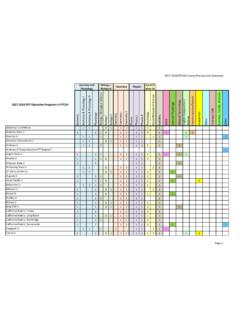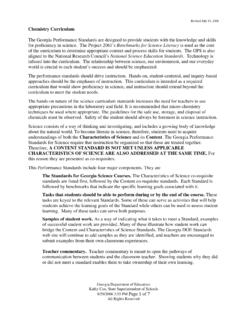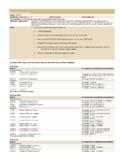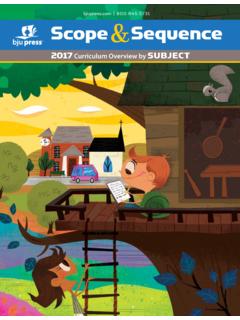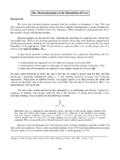Transcription of Radioactive Decay and Half-Life
1 Science Enhanced Scope and Sequence chemistry Radioactive Decay and Half-Life Strand Atomic Structure and Periodic Relationships Topic Investigating atomic structure Primary SOL The student will investigate and understand that the placement of elements on the periodic table is a function of their atomic structure. The periodic table is a tool used for the investigations of b) isotopes, half -lives, and Radioactive Decay . Related SOL The student will investigate and understand that experiments in which variables are measured, analyzed, and evaluated produce observations and verifiable data. Key concepts include h) use of appropriate technology including computers, graphing calculators, and probeware for gathering data, communicating results, and using simulations to model concepts. Background Information Radioactive Decay is the process by which an atomic nucleus of an unstable atom loses energy by emitting ionizing particles (ionizing radiation).
2 There are many different types of Radioactive Decay The Decay product formed during Radioactive Decay is known as the daughter product or daughter nuclide. A Decay , or loss of energy, results when an atom with one type of nucleus, called the parent radionuclide, transforms to an atom with a nucleus in a different state, or to a different nucleus containing different numbers of protons and neutrons. Half-Life is the period of time it takes for the amount of a substance undergoing Decay to decrease by half . The name was originally used to describe a characteristic of unstable atoms ( Radioactive Decay ), but it may apply to any quantity which follows a set-rate Decay . Common isotopes to use in this activity are carbon-14, iodine-131, cobalt-60, hydrogen-3, strontium-90, and uranium-238, although any Radioactive isotope with a known Decay type and Half-Life can be used. It works well to identify the isotope with a sticky note on the top of each group's container.
3 Materials For each group of students: Container with top 100 pennies Plastic cup Periodic table of the elements Attached table of isotopic Decay types and half -lives For each student: Graph paper Ruler Attached activity sheet virginia department of education 2012 1. Science Enhanced Scope and Sequence chemistry Vocabulary Half-Life , isotope, Radioactive Decay Student/Teacher Actions (what students and teachers should be doing to facilitate learning). Procedure 1. Group students, and have each group perform the activity described on the attached activity sheet. Pennies represent atoms of the given isotope, and any penny that comes up tails upon turning the container has decayed to a new element. 2. Have each student complete the data table, graph, and questions on the activity sheet. Assessment Questions o Scientists are able to date ancient geological formations by finding the amount of certain uranium isotopes contained in the rock layer. Why are uranium isotopes useful in determining the age of ancient geological formations?
4 O How can Radioactive dating be useful when the temperatures and pressures to which the geological formation has been exposed have varied so much throughout history? Extensions and Connections (for all students). Have students investigate the uses and dangers, if any, of the isotope that they used in the model. Invite a radiologist technician to explain various ways radiation is used in everyday life and in industry ( , smoke detectors, food industry, carbon dating for archaeological finds). Have students explore how radio isotopes with short half -lives are used in the medical field and site examples to present to the class. Strategies for Differentiation Have students use enlarged graph paper to create the graph for the lab data. Have students use a Geiger counter or other rad. Have students color code on the data table the variable that will be graphed on each axis and correspond on the graph itself. Have students highlight an assigned radioisotope on the given table.
5 Have students work in groups of two or four to prepare a presentation on radiation and how it is used in homes. virginia department of education 2012 2. Science Enhanced Scope and Sequence chemistry Radioactive Decay and Half-Life Activity Sheet Name: Date: Instructions The 100 pennies in your group's container represent the atoms of a Radioactive isotope. 1. Seal the container, and turn it over six times. This represents one Half-Life period. 2. Remove any pennies that come up tails, and place them in a plastic cup. These pennies represent those atoms that have undergone Radioactive Decay . 3. Count the heads-up pennies that remain in the original container, and record the number in the data table below. 4. Repeat steps 1 3 with the remaining pennies to represent three additional Half-Life periods. Data Table Half-Life Period Time (sec.) Atoms Remaining Mass of Atoms (amu). 0 0 100. 1. 2. 3. 4. Data Analysis On graph paper, graph mass versus time from your data table.
6 Plot all points, and then use the ruler to connect them with a line of best fit. Be sure to label each axis and title your graph. Conclusions 1. Write the nuclear Decay equation for the radioisotope that you were given. 2. For your isotope, find the amount of time that elapses in Half-Life periods. Show your work. 3. Ancient geological formations are often dated by finding the amount of certain uranium isotopes contained in the rock layer. Why are uranium isotopes useful in determining the age of ancient geological formations? How can Radioactive dating be useful when the temperatures and pressures to which the geological formation has been exposed have varied so much throughout history? virginia department of education 2012 3. Science Enhanced Scope and Sequence chemistry Selected Radioisotopes Decay Nuclide Nuclide Half-Life Mode Name 198. Au d gold-198. 14. C 5730 y carbon-14. 37. Ca 175 ms + calcium-37. 60. Co y cobalt-60. 137. Cs y cesium-137.
7 53. Fe min + iron-53.. 220. Fr s francium-220. 3. H y hydrogen-3. 131. I d iodine-131. 37. K s + potassium-37. 42. K h potassium-42. 85. Kr y krypton-85. 16. N s nitrogen-16. 19. Ne s + neon-19. 32 phosphorus- P d . 32. plutonium- . 239. Pu 104 y 239.. 226. Ra 1600 y radium-226.. 222. Rn d radon-222. 90. Sr y strontium-90. 99 technetium- Tc 105 y . 99.. 232. Th 1010 y thorium-232.. 233. U 105 y uranium-233.. 235. U 108 y uranium-235.. 238. U 109 y uranium-238. ms = milliseconds; s = seconds; min = minutes;. h = hours; d = days; = years virginia department of education 2012 4. Science Enhanced Scope and Sequence chemistry Symbols Used in Nuclear chemistry Name Notation Symbol alpha particle . beta particle . (electron). gamma radiation . neutron n proton p positron +. virginia department of education 2012 5.










